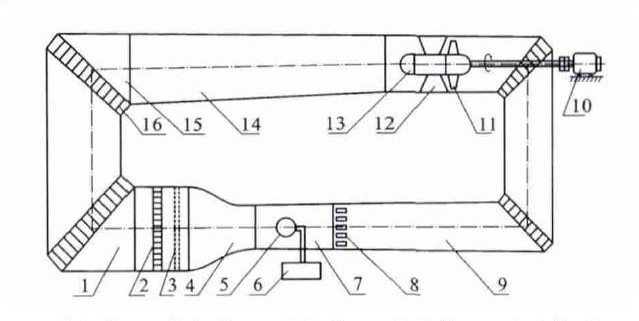-
摘要: 为了优化重型卡车的风阻系数, 研究了卡车尾部扰流翼和驾驶室与货箱连接间隙调整对阻力系数降低的作用, 并考虑了无风条件下实际行驶过程中地面与车体相对运动和车轮受压形状改变对阻力的影响。运用低速风洞试验与商业软件FLUENT, 在不同减阻附件安装情况下, 分析了美国标准Class 8卡车的车身绕流特性与阻力系数的变化。研究结果表明: 车身连接处与尾部扰流翼减阻附件的安装可以减弱货箱前部气流分离和尾部涡量, 从而降低卡车阻力系数。在90km·h-1经济速度下, 安装2组减阻附件后的卡车阻力系数最高可降低16.2%, 最小值可达到0.485 4。Abstract: To optimize the drag coefficient of heavy truck, the effect of rear spoilers and linking seals between cab and packing case was tested, in which the relative motion between truck and road and the pressed deformations of tires in real running under windless conditions were considered. The numerical simulation using commercial computational fluid dynamics software FLUENT and low-speed wind tunnel experiments were carried out to investigate the airflow characteristics around the US standard Class 8 truck and the drag coefficients of truck with different add-on devices. Analysis result indicates that by attaching the proper add-on devices, such as linking seals and rear spoilers, the rear vortices and front airflow sparation of packing case reduce, which results in the significant reduction of drag coefficient. At commercial speed of 90 km·h-1, drag coefficient decreases by 16.2% and its minimum value is 0.485 4.
-
表 1 风洞参数
Table 1. Parameters of wind tunnel

表 2 阻力系数
Table 2. Resistance coefficients

表 3 计算参数
Table 3. Calculation parameters

表 4 模拟边界条件
Table 4. Boundary conditions of simulation

表 5 完整模拟边界条件
Table 5. Boundary conditions of comprehensive simulation

表 6 试验结果
Table 6. Experimental result

-
[1] 李名升, 于洋, 李铭煊, 等. 中国工业SO2排放量动态变化分析[J]. 生态环境学报, 2010, 19 (4): 957-961. https://www.cnki.com.cn/Article/CJFDTOTAL-TRYJ201004039.htmLI Ming-sheng, YU Yang, LI Ming-xuan, et al. Analysis on the dynamics change of industrial SO2 emissions in China[J]. Ecology and Environmental Sciences, 2010, 19 (4): 957-961. (in Chinese). https://www.cnki.com.cn/Article/CJFDTOTAL-TRYJ201004039.htm [2] 李新艳, 李恒鹏. 中国大气NH3和NOx排放的时空分布特征[J]. 中国环境科学, 2012, 32 (1): 37-42. https://www.cnki.com.cn/Article/CJFDTOTAL-ZGHJ201201005.htmLI Xin-yan, LI Heng-peng. Emission and distribution of NH3 and NOx in China[J]. China Environmental Science, 2012, 32 (1): 37-42. (in Chinese). https://www.cnki.com.cn/Article/CJFDTOTAL-ZGHJ201201005.htm [3] 傅立敏. 用空气动力学附架装置降低国产货车气动阻力措施的探讨[J]. 汽车工程, 1994, 16 (3): 144-148, 181. https://www.cnki.com.cn/Article/CJFDTOTAL-QCGC199403002.htmFU Li-min. An investigation to the effects of add-on devices on reducing aerodynamic drag of domestic trucks[J]. Automotive Engineering, 1994, 16 (3): 144-148, 181. (in Chinese). https://www.cnki.com.cn/Article/CJFDTOTAL-QCGC199403002.htm [4] 高利, 高延龄, 陈荫三. 长头厢式货车加装导流罩的风洞和道路试验研究[J]. 中国公路学报, 1995, 8 (3): 50-58. https://www.cnki.com.cn/Article/CJFDTOTAL-ZGGL503.009.htmGAO Li, GAO Yan-ling, CHEN Yin-san. Wind tunnel tests and road tests of long head box van with cab roof fairing[J]. China Journal of Highway and Transport, 1995, 8 (3): 50-58. (in Chinese). https://www.cnki.com.cn/Article/CJFDTOTAL-ZGGL503.009.htm [5] 杜广生, 赵兰水, 刘连山, 等. 厢式载货汽车模型风洞试验技术的研究[J]. 汽车技术, 1996 (9): 15-17, 34. https://www.cnki.com.cn/Article/CJFDTOTAL-QCJS609.004.htmDU Guang-sheng, ZHAO Lan-shui, LIU Lian-shan, et al. Study of wind tunnel test technology on van model[J]. Automotive Technology, 1996 (9): 15-17, 34. (in Chinese). https://www.cnki.com.cn/Article/CJFDTOTAL-QCJS609.004.htm [6] 欧阳鸿武, 唐艳君, 张志沛, 等. EQ1092型载货车加装气动附加装置的模型风洞试验研究[J]. 汽车技术, 2001 (6): 15-18. https://www.cnki.com.cn/Article/CJFDTOTAL-QCJS200106004.htmOUYANG Hong-wu, TANG Yan-jun, ZHANG Zhi-pei, et al. Study of wind tunnel test for model EQ1092truck with aerodynamic attachment devices[J]. Automotive Technology, 2001 (6): 15-18. (in Chinese). https://www.cnki.com.cn/Article/CJFDTOTAL-QCJS200106004.htm [7] 赵兰水, 孔祥雷. 井字形格栅对厢式货车减小气动阻力的实验研究[J]. 兵工学报, 2002, 23 (3): 399-401. https://www.cnki.com.cn/Article/CJFDTOTAL-BIGO200203031.htmZHAO Lan-shui, KONG Xiang-lei. An experimental study of square-formed fences for reducing the aerodynamic drag of a van truck[J]. Acta Armamentarii, 2002, 23 (3): 399-401. (in Chinese). https://www.cnki.com.cn/Article/CJFDTOTAL-BIGO200203031.htm [8] 吴志刚, 魏琪, 加藤征三, 等. 利用导流装置降低大后壁车辆气动阻力的实验研究(Ⅰ)[J]. 空气动力学学报, 2003, 21 (4): 391-398. https://www.cnki.com.cn/Article/CJFDTOTAL-KQDX200304002.htmWU Zhi-gang, WEI Qi, SEIZO K, et al. Experimental study on reducing large bluff-based vehicles'drag by using guide vances (Ⅰ)[J]. Acta Aerodynamica Sinica, 2003, 21 (4): 391-398. (in Chinese). https://www.cnki.com.cn/Article/CJFDTOTAL-KQDX200304002.htm [9] 谷正气, 李学武, 何忆斌. 汽车减阻新方法[J]. 汽车工程, 2008, 30 (5): 441-443, 448. https://www.cnki.com.cn/Article/CJFDTOTAL-QCGC200805016.htmGU Zheng-qi, LI Xue-wu, HE Yi-bin. A new method of reducing aerodynamic drag[J]. Automotive Engineering, 2008, 30 (5): 441-443, 448. (in Chinese). https://www.cnki.com.cn/Article/CJFDTOTAL-QCGC200805016.htm [10] 郑智颖, 白哲, 徐鸿鹏, 等. 厢式货车尾部打孔装置减阻特性研究[J]. 节能技术, 2011, 29 (2): 108-112. https://www.cnki.com.cn/Article/CJFDTOTAL-JNJS201102004.htmZHENG Zhi-ying, BAI Zhe, XU Hong-peng, et al. Study on drag reduction characteristics of hole-drilled aerodynamic device attached in the rear of van[J]. Energy Conservation Technology, 2011, 29 (2): 108-112. (in Chinese). https://www.cnki.com.cn/Article/CJFDTOTAL-JNJS201102004.htm [11] 杜广生. 厢式货车空气动力学特性的研究[D]. 无锡: 中国船舶科学研究中心, 2002.DU Guang-sheng. Study on aerodynamic characteristics of van body truck[D]. Wuxi: China Ship Scientific Research Center, 2002. (in Chinese). [12] BROWAND F, RADOVICH C, BOIVIN M. Fuel savings by means of flaps attached to the base of a trailer: field test result[J]. SAE Paper, 2005-01-1016. [13] HU Yang-yang. Computational investigation of drag reduction with a rear flap on trucks[D]. Birmingham: University of Alabama, 2012. -





 下载:
下载:

















